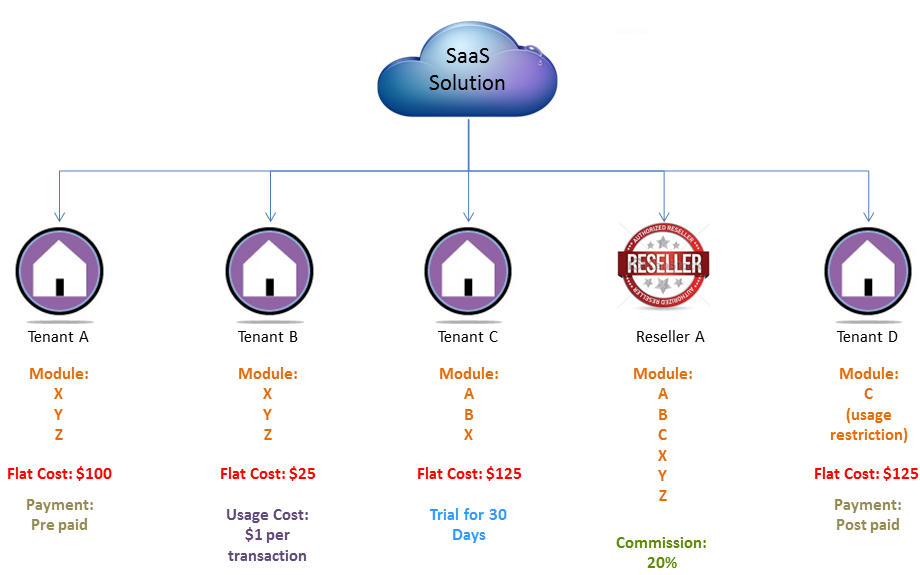Subscription management is one of the under estimated areas in SaaS model. SaaS ISVs tend to focus more on the product engineering side and pay very little attention to the operations and manageability of the SaaS business.
At the outset, SaaS subscription management can look as simple as collecting money on a monthly (or recurring) basis from the customer. But that’s only the tip of the ice berg. Infact, majority of the task involved in subscription management has to do with the way you would like to operate your SaaS business model.
World is moving towards subscription
SaaS solutions today have reached the levels where you can sign-up and start using the trial in less than 2 minutes. Offering self-registration capability and availability of the product in live trial will help in cutting down the sales cycle. Having module wise access of the product, will allow the customer to pick and choose the modules that are required. These modules can be priced individually, which will benefit both ISV and customers. Let’s look at few scenarios that can give you an idea on the variations you can bring in your SaaS Subscription model.
Variation #1
Tenant A – has subscribed to modules ‘X’, ‘Y’ and ‘Z’ at a monthly flat cost of 100 USD, and will be paying it in a pre-paid model (i.e. the payment will be made at the start of the month).
Variation #2
Tenant B – has subscribed to the same set of modules just like Tenant A, but will be paying on a usage based model. It will be a monthly (base) flat cost of 25 USD plus 1 USD per transaction, which will be done through the SaaS system. For example, if this tenant has done 53 transactions in a given month, then they will be paying 25 + 53 = 78 USD on a post-paid model.
Variation #3
Tenant C – has subscribed to modules ‘A’, ‘B’ and ‘X’ at a monthly flat cost of 125 USD, but will be on SaaS trial mode for the first 30 days. So, the first 30 days of usage by this customer should not be considered for SaaS invoicing (or rather for applying cost). Your SaaS solution should be able to differentiate between a paying customers, non-paying customers, paying customers currently on trial mode and non-paying customers on trial mode.
Variation #4
Reseller A – this SaaS reseller has access to all modules. However, as an ISV you may want to control what modules can be available for which resellers. This is required when your solution serves multiple domains, and hence you may have domain based resellers. For SaaS resellers, you will be billing 20% of the total revenue accrued by that reseller in that month. In order to do that you should know the exact data on the revenues that have come through the tenants boarded by this reseller.
Variation #5
Tenant D – has subscribed to only one module ‘C’ at a monthly flat cost of 125 USD, but will be paying it in a post-paid model (i.e. the payment will be made at the end of the month). In addition to this, there is a usage limitation that has to be applied for this tenant. For example, this tenant can only perform 100 transactions per month, beyond that the system should restrict the transactions.
The above scenarios are just few examples to show the variations (or rather innovations) you can bring in to attract more customers. One of the key innovation area would be the value based pricing models, as shown in case of Tenant B, where the billing was done based on the value the customer could yield from your solution.
Manual choice – dead end
As you can see from the above scenarios, there are several attributes (color coded in the above picture) that have to be considered while managing the subscriptions of your customer. It’s extremely difficult, time consuming and error prone to manage these subscriptions in a manual way. As you grow, this effort will only increase multi-fold. Therefore, having an automated way of managing the entire subscription and billing process can save significant time, effort and customer dissatisfaction (as result of billing errors).
You can reach me at [email protected] to share your comments.
- Top 10 NFR in Software Architecture – Part 1 - December 1, 2022
- Top 10 Critical NFR for SaaS Applications – Part 2 - October 20, 2022
- Why enterprises should standardize Digital Application Management - July 17, 2017







Comments